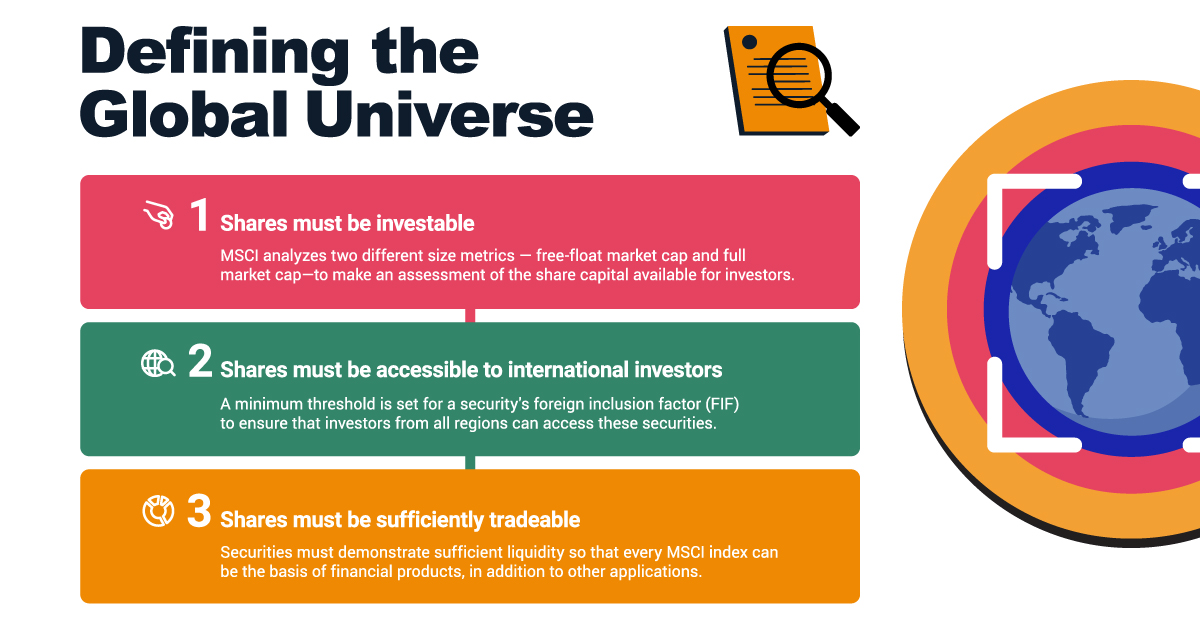Bringing the World Into Focus: A Guide to MSCI Indexes
The following content is sponsored by MSCI

Bringing the World Into Focus: A Guide to MSCI Indexes
Economic development around the world has led investors to consider broadening their investment exposures.
But with nearly 30,000 equity securities available globally, the universe is far too large for an investor to filter by themselves.
In this sponsored infographic from MSCI, we explain their index creation process that allows them to map and categorize the stock market.
Defining the Global Universe
Although a majority of global market capitalization is located in the U.S., overseas markets (both developed and emerging) are home to thousands of publicly-listed companies.
Thus, the first step that MSCI takes is identifying eligible securities from public stock markets. Mutual funds, ETFs, and equity derivatives are screened out. This leaves ordinary and preferred shares, share equivalents, and real estate investment trusts (REITs).
Share equivalents are securities that can be converted into company shares. This includes securities such as American depository receipts (ADRs), which are certificates issued by U.S. banks that represent a specified number of a foreign company’s shares. Meanwhile, REITs are companies that own and operate income-producing real estate such as office buildings.
Applying Investability Screens
A stock index is not useful if its underlying securities are not widely accessible.
To create an investable representation of the global market, MSCI screens its universe of eligible securities according to three requirements.
1. Shares must be investable
MSCI analyzes two different size metrics—free-float market cap and full market cap—to make an assessment of the share capital available for investors.
Free-float market cap refers the value of shares readily available in public markets, while full market cap is equal to the former, plus the value of shares provided through a company’s equity issuance plans. For a company to be included in an MSCI index, it must meet the minimum target for both of these metrics.
2. Shares must be accessible to international investors
To ensure that investors from all regions can access its indexes, MSCI sets a minimum threshold for a security’s foreign inclusion factor (FIF).
The FIF of a security is the proportion of shares outstanding that is publicly available for purchase by international investors.
3. Shares must be sufficiently tradeable
The underlying securities of an index must have sufficient liquidity so that the index can be used as a benchmark for ETFs and other products.
MSCI uses two metrics to determine how liquid a stock is, with the first being 3 month frequency of trading (FOT). This metric compares the number of days a stock traded during a 3 month period, with the maximum number of trading days in that period.
The second metric is the annual traded value ratio (ATVR), which measures the percentage of total share value that is traded every year. This enables MSCI to identify stocks with stable long- and short-term liquidity.
Classifying Companies
At this stage, MSCI has an investable representation of the global market.
The next step is to classify every company into three non-overlapping categories, enabling MSCI to create indexes that target specific countries, regions, or sectors. Indexes can also focus on larger or smaller companies.
| Category | Detail |
|---|---|
| Country | A company and its securities can only be classified in one country. MSCI considers criteria such as:
|
| Sector | Using the Global Industry Classification Standard (GICS), a company is assigned to the sector that best describes its business activities. GICS consists of:
|
| Size | A company can only be assigned to one size segment. These are:
|
Over 50 Years of Index Development
The world’s equity universe is constantly changing, opening up new opportunities within industries, countries, and even entire regions.
While some investors aim to support the fight against climate change, others look to take advantage of long-term structural trends. Regardless of the objective, investors need a starting point from which they can build a relevant portfolio.
MSCI indexes seek to provide extensive coverage of the world’s opportunities, giving investors the tools they need to shape and refine their investment allocations.
-

 Sponsored3 years ago
Sponsored3 years agoMore Than Precious: Silver’s Role in the New Energy Era (Part 3 of 3)
Long known as a precious metal, silver in solar and EV technologies will redefine its role and importance to a greener economy.
-

 Sponsored7 years ago
Sponsored7 years agoThe History and Evolution of the Video Games Market
Everything from Pong to the rise of mobile gaming and AR/VR. Learn about the $100 billion video games market in this giant infographic.
-

 Sponsored8 years ago
Sponsored8 years agoThe Extraordinary Raw Materials in an iPhone 6s
Over 700 million iPhones have now been sold, but the iPhone would not exist if it were not for the raw materials that make the technology...
-

 Sponsored8 years ago
Sponsored8 years agoThe Industrial Internet, and How It’s Revolutionizing Mining
The convergence of the global industrial sector with big data and the internet of things, or the Industrial Internet, will revolutionize how mining works.


